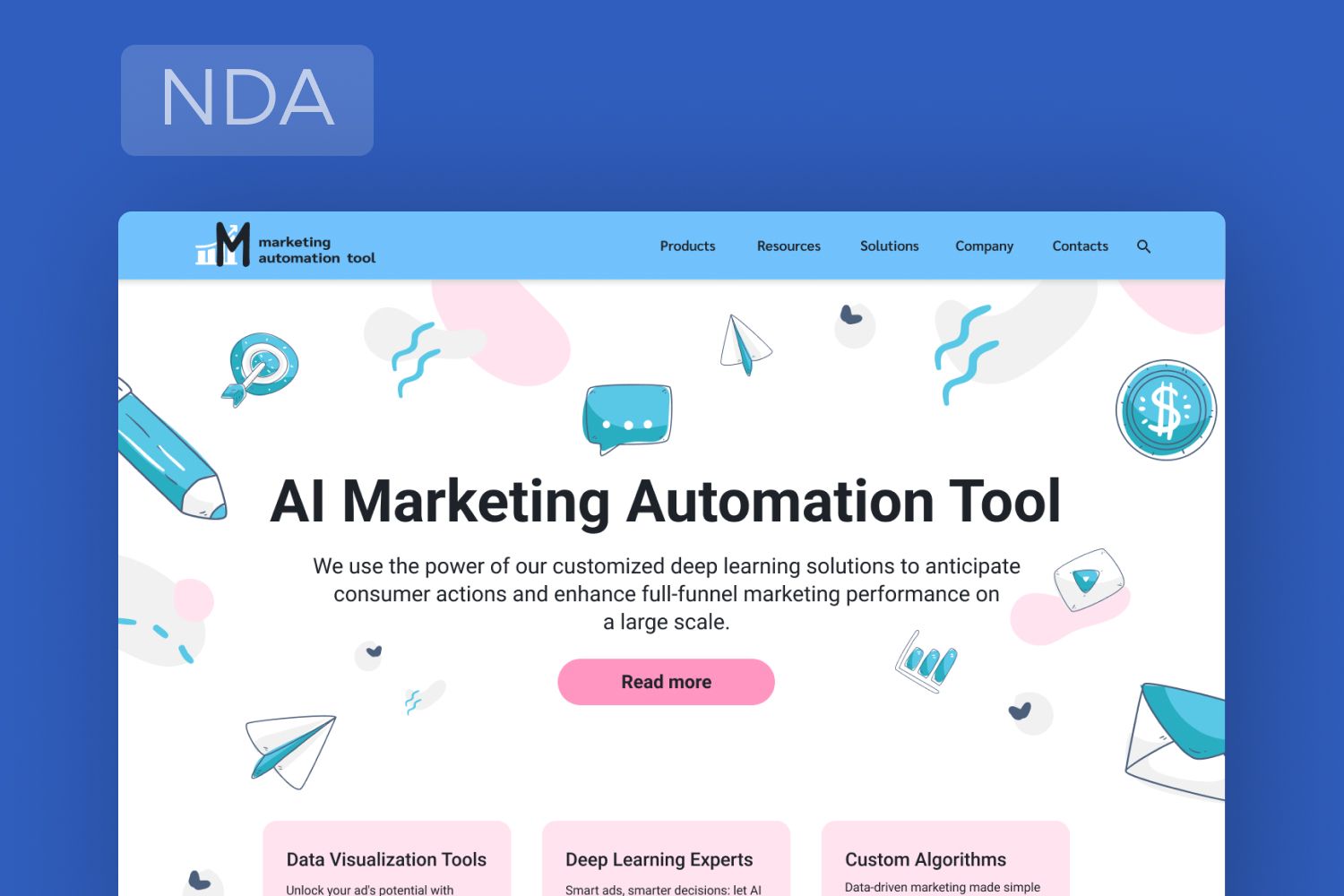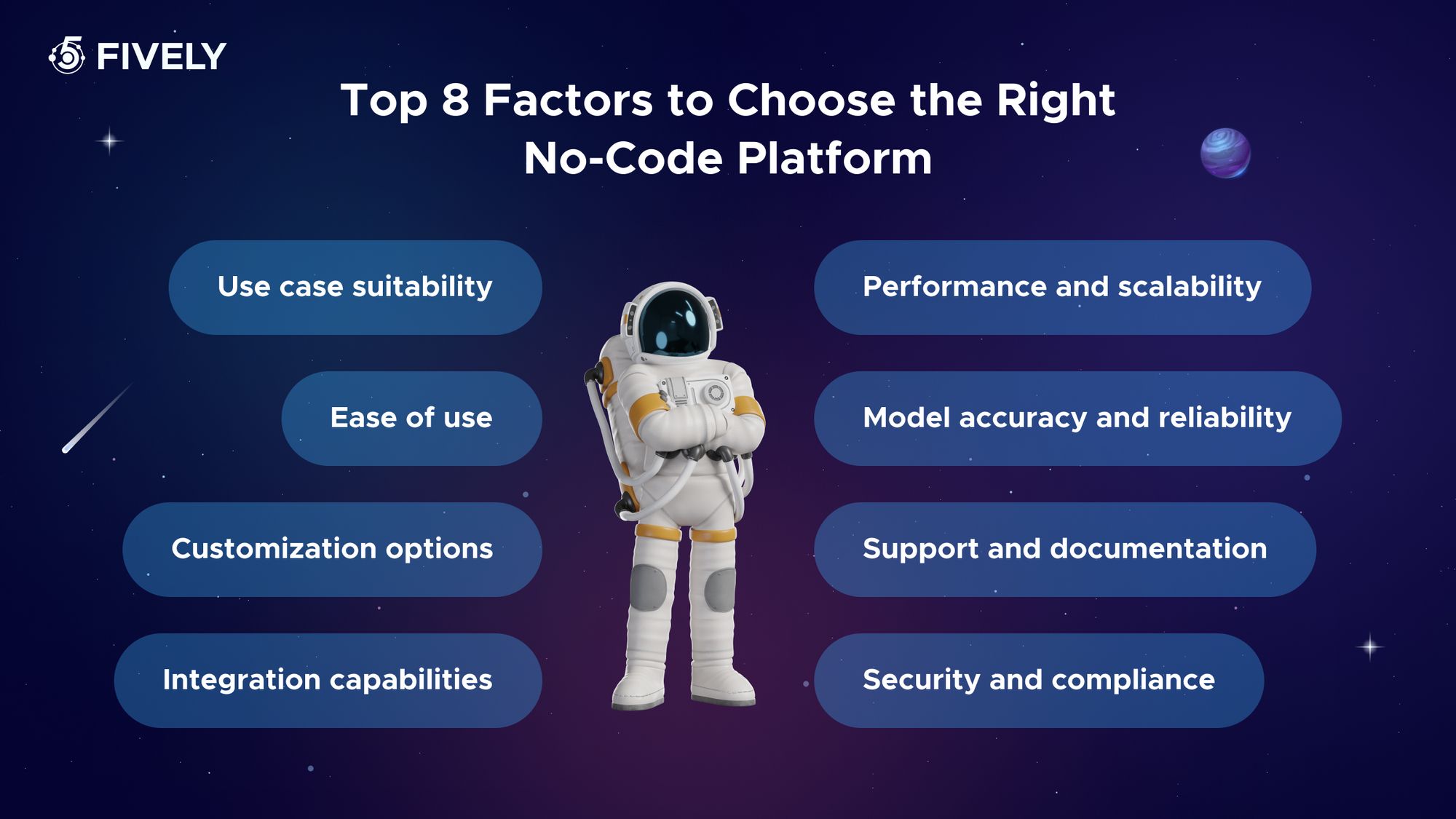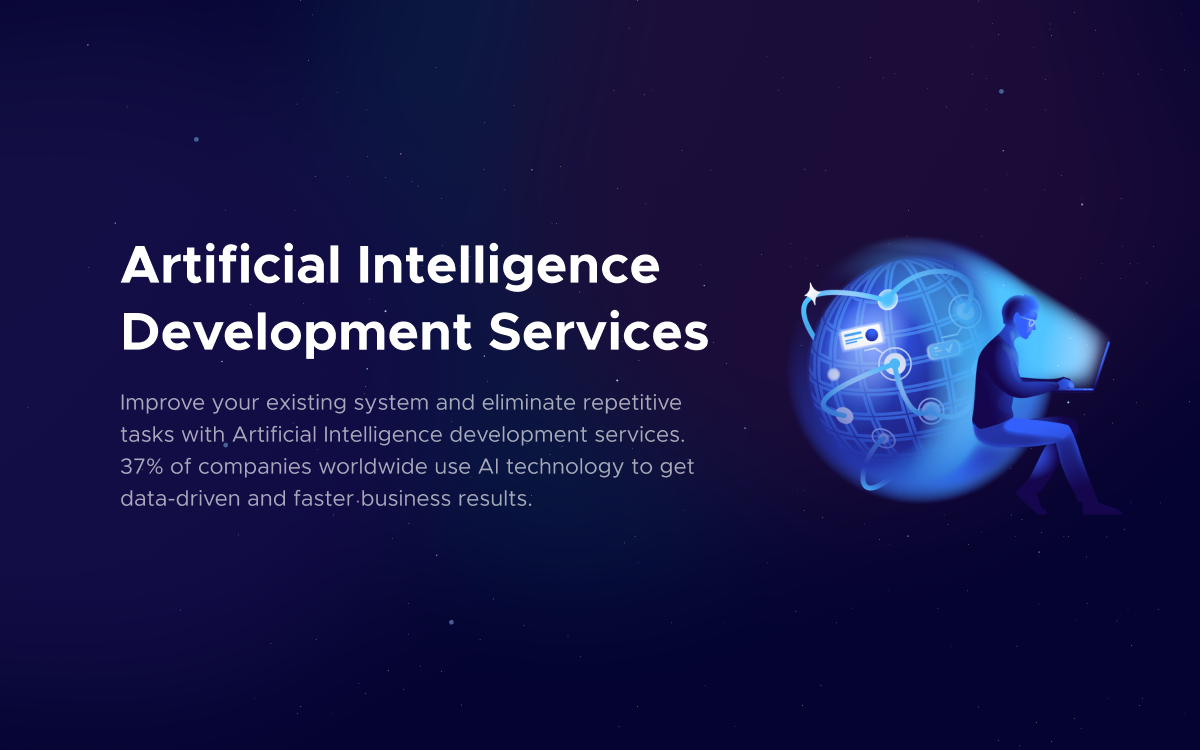14 Best No-Code AI SaaS Tools
Discover the benefits of implementing no-code AI tools into your workflow, get the list of the top 10 no-code AI solutions, and check our advice on how to choose the fitting one.
In today’s world, where technology evolves at lightning speed, the demand for innovative solutions that streamline business processes without the need for extensive coding is higher than ever.
In our fresh article, let’s touch upon no-code SaaS AI tools – a game-changer for companies seeking to harness the power of AI without the complexity of traditional development.
Today, we'll explore the top benefits of choosing these tools, as well as some of the top no-code AI SaaS tools revolutionizing industries and empowering users to create intelligent applications with ease. Let’s start!
What Is Low-code and No-code AI?
Low-code and no-code AI refer to platforms and tools that enable users to build and deploy artificial intelligence models and applications with minimal or no coding required.
These platforms typically offer visual interfaces, drag-and-drop functionalities, and pre-built components that allow users to create AI solutions using simple configurations and workflows. With low-code/no-code AI, individuals with limited programming skills can harness the power of AI to solve complex problems and automate tasks without having to write extensive lines of code.
This democratization of AI empowers a broader range of users, including business analysts, domain experts, and citizen developers, to innovate and drive digital transformation initiatives within their organizations.
Top 7 Reasons to Use No-Code AI Platforms
As you may guess, no-code AI tools offer numerous benefits and compelling reasons for their adoption:
- Accessibility: No-code AI platforms democratize access to AI technology, allowing individuals with varying levels of technical expertise to leverage AI capabilities without extensive coding knowledge;
- Rapid development: These platforms streamline the AI development process by providing intuitive interfaces and pre-built templates, enabling users to create AI solutions quickly and efficiently;
- Cost-effectiveness: By eliminating the need for hiring specialized AI developers and reducing development time, no-code AI platforms can significantly lower development costs and accelerate time-to-market for AI applications;
- Empowerment: No-code and low-code AI platforms empower business users, domain experts, and citizen developers to take ownership of AI projects and innovate within their respective domains without relying on IT or data science teams;
- Flexibility: With customizable workflows and modular components, no-code AI platforms offer flexibility in building AI solutions tailored to specific business requirements and use cases;
- Scalability: No-code SaaS AI tools often leverage cloud-based infrastructure, allowing for seamless scalability and on-demand resource allocation as AI applications grow and evolve;
- Innovation: By enabling rapid experimentation and prototyping, low-code AI platforms foster a culture of innovation within organizations, encouraging users to explore new ideas and iterate on AI solutions more freely.
Overall, the pros of no-code AI platforms make them invaluable resources for businesses seeking to harness the power of AI for solving complex problems, driving efficiencies, and gaining competitive advantages in today's digital landscape.
Top 14 No-code AI Tools
The platforms we collected below empower users to build AI solutions without the need for extensive coding or data science expertise. Let's explore some of the top players in the field:
Amazon SageMaker
Renowned as a premier machine learning service, Amazon SageMaker empowers developers to construct, train, and deploy machine learning models at scale. Offering no-code capabilities, SageMaker enables users to craft custom models effortlessly through pre-built algorithms and intuitive drag-and-drop interfaces, eliminating the need for manual coding. Moreover, SageMaker streamlines the entire machine learning workflow with built-in tools for data preprocessing, model tuning, and deployment, catering to both beginners and experienced data scientists alike, providing a user-friendly environment for building robust AI applications in the cloud.
Google Teachable Machine
It stands out as a user-friendly platform designed for crafting custom machine learning models without the necessity of coding. Through Teachable Machine, users can train models to recognize images, sounds, and poses using straightforward drag-and-drop interfaces. The platform offers pre-trained models and tutorials to expedite the onboarding process, ensuring accessibility for both novices and experts. Whether embarking on prototyping endeavors or delving into advanced AI concepts, Teachable Machine offers an engaging and intuitive avenue for exploring the boundless potential of machine learning.
Google AutoML
This tool emerges as a comprehensive suite of machine learning tools tailored to empower users in building custom models devoid of coding or data science expertise. AutoML facilitates model training for tasks such as image classification, text recognition, and translation through intuitive graphical interfaces. By automating model training, tuning, and deployment, the platform allows users to concentrate on data analysis and business objectives. Furthermore, AutoML offers advanced functionalities like hyperparameter optimization and transfer learning, enabling users to develop top-tier models with minimal effort.
Microsoft Lobe
Microsoft's Lobe stands as a user-friendly platform designed for crafting customized ML models via intuitive drag-and-drop interfaces. It empowers users to train models for tasks like object recognition and image classification without the need for coding. With Lobe, users benefit from a visual interface that simplifies data preprocessing, model training, and evaluation, facilitating experimentation with diverse algorithms and techniques. Furthermore, Lobe seamlessly integrates with popular machine learning frameworks like TensorFlow and PyTorch, enabling users to leverage existing libraries and tools effortlessly.
Apple CreateML
Apple's CreateML is a machine learning framework that enables developers to build custom models directly within Xcode, Apple's integrated development environment. With CreateML, developers can train models for tasks such as image recognition, natural language processing, and sound classification using simple graphical interfaces. The framework provides built-in support for data preprocessing, model training, and evaluation, making it easy to create high-quality models with minimal effort. Additionally, CreateML offers integration with Core ML, Apple's machine learning framework for deploying models on iOS, macOS, watchOS, and tvOS devices, allowing developers to build end-to-end AI solutions within the Apple ecosystem.
Akkio
Akkio is a user-friendly no-code AI platform designed to empower businesses to create and implement AI-driven solutions effortlessly. Its intuitive drag-and-drop interface allows users to craft custom machine learning models tailored to various needs like predictive analytics, customer segmentation, and recommendation engines. Featuring a rich library of pre-built templates and workflows, Akkio ensures a smooth start for users of all skill levels. Moreover, it streamlines the AI development process with built-in tools for data integration, model training, and deployment.
DataRobot
DataRobot stands out as a top-tier automated machine learning platform, facilitating organizations in building and deploying machine learning models on a large scale. Its no-code AI capabilities empower users to develop custom models for predictive analytics, time series forecasting, and more, eliminating the need for coding. With an intuitive visual interface, DataRobot allows for seamless data exploration, model building, and evaluation, enabling users to experiment with diverse algorithms and techniques effortlessly. Furthermore, it offers advanced functionalities like automated feature engineering, hyperparameter optimization, and model interpretability for creating high-quality models efficiently.
Levity
Levity emerges as a versatile no-code AI platform, empowering users to construct bespoke machine learning models for tasks such as image recognition, text classification, and data extraction. Its intuitive interface simplifies the model training process through straightforward drag-and-drop workflows, allowing users to upload data and train models effortlessly. Leveraging pre-built models and templates for common use cases, Levity ensures a seamless entry into the world of AI for users with varying coding expertise. Additionally, it provides built-in tools for model evaluation and deployment, facilitating the smooth integration of AI into applications.
Nanonets
Nanonets is a no-code AI platform that specializes in image recognition and document processing. With Nanonets, users can train custom models for tasks such as object detection, optical character recognition (OCR), and text extraction using simple drag-and-drop interfaces. The platform provides pre-trained models and tutorials to help users get started quickly, making it accessible to users of all skill levels. Additionally, Nanonets offers advanced features such as data augmentation, model tuning, and deployment automation, enabling users to create high-quality models with minimal effort.
ObviouslyAI
ObviouslyAI is an AI platform that enables users to build and deploy predictive models without writing any code. With ObviouslyAI's intuitive interface, users can upload their data and train models for tasks such as sales forecasting, customer churn prediction, and lead scoring using simple drag-and-drop workflows. The platform provides built-in tools for data preprocessing, feature engineering, and model evaluation, making it easy to create accurate and actionable insights from your data. Additionally, ObviouslyAI offers integration with popular business intelligence tools and platforms, allowing users to seamlessly integrate AI into their existing workflows.
PyCaret
PyCaret is a low-code machine learning library in Python that enables users to perform end-to-end data science workflows with minimal coding. With PyCaret's simple API, users can easily train, evaluate, and deploy machine learning models using a few lines of code. The library provides a wide range of pre-built algorithms and pipelines for classification, regression, clustering, and anomaly detection tasks, making it suitable for both beginners and experienced data scientists. Additionally, PyCaret offers built-in tools for data preprocessing, feature selection, and model tuning, allowing users to create high-performing models with ease.
Pecan
Pecan is a no-code AI platform that specializes in natural language processing (NLP) and text analytics. With Pecan's intuitive interface, users can analyze text data, extract insights, and build custom NLP models without writing any code. The platform offers a range of pre-trained models and tools for tasks such as sentiment analysis, entity recognition, and text summarization, making it easy to get started with NLP. Additionally, Pecan provides built-in features for data visualization, model interpretation, and deployment, allowing users to derive actionable insights from their text data with minimal effort.
Causaly
Causaly is a no-code AI platform that enables users to explore causal relationships in biomedical data. With Causaly's intuitive interface, users can visualize complex networks of causal relationships between diseases, drugs, genes, and other biomedical entities. The platform leverages advanced machine learning algorithms and natural language processing techniques to extract causal insights from unstructured biomedical data sources, such as scientific literature and clinical trial reports. Additionally, Causaly provides built-in tools for hypothesis generation, evidence validation, and knowledge sharing, empowering researchers and healthcare professionals to make informed decisions and drive medical innovation.
MLJAR
MLJAR is an AI platform that offers automated machine learning (AutoML) solutions for a wide range of use cases. With MLJAR's intuitive interface, users can upload their data and let the platform automatically train and optimize machine learning models for tasks such as classification, regression, and time series forecasting. The platform supports a variety of algorithms and techniques, including gradient boosting, random forest, and neural networks, making it suitable for both simple and complex predictive modeling tasks. Additionally, MLJAR provides built-in tools for model interpretation, hyperparameter tuning, and deployment, allowing users to create production-ready models with minimal effort.

How to Choose the Right No-Code Platform
When selecting the right no-code or low-code AI platform for your needs, several factors should be considered to ensure compatibility and effectiveness:
- Use case suitability: Determine whether the platform supports the specific use cases and tasks you need to accomplish, such as image recognition, natural language processing, or predictive analytics;
- Ease of use: Evaluate the platform's user interface and workflow to ensure it aligns with your team's technical expertise and preferences. Look for intuitive drag-and-drop interfaces, pre-built templates, and guided workflows that simplify the development process;
- Customization options: Assess the level of customization offered by the platform, including the ability to tailor models, algorithms, and workflows to your unique requirements. Look for platforms that provide flexibility without sacrificing simplicity;
- Integration capabilities: Consider the platform's compatibility with existing systems, databases, and third-party tools within your organization's tech stack. Look for platforms that offer seamless integration options and support standard data formats and protocols;
- Performance and scalability: Evaluate the platform's performance and scalability to ensure it can handle large volumes of data and processing tasks effectively. Look for platforms that offer robust infrastructure, parallel processing capabilities, and scalability options to support growing needs;
- Model accuracy and reliability: Assess the platform's track record in delivering accurate and reliable AI models, as well as its ability to handle diverse data types and sources. Look for platforms that leverage advanced algorithms, model validation techniques, and quality assurance processes to ensure high-quality results;
- Support and documentation: Consider the level of support and documentation provided by the platform vendor, including training resources, tutorials, and technical assistance. Look for platforms that offer responsive customer support, comprehensive documentation, and community forums for knowledge sharing and troubleshooting;
- Security and compliance: Ensure that the platform adheres to industry standards and best practices for data security, privacy, and regulatory compliance. Look for platforms that offer robust security features, data encryption, access controls, and compliance certifications to protect sensitive information and ensure legal compliance.

By carefully considering these factors, you can choose the right no-code AI platform that meets your organization's needs and empowers you to build powerful AI solutions with ease.
The Future of No-Code AI Apps Is Here
The advent of no-code and low-code AI platforms represents a significant milestone in democratizing access to artificial intelligence and machine learning technologies. With the rise of user-friendly tools like Amazon SageMaker, Google AutoML, and Microsoft Lobe, individuals and organizations of all skill levels can now harness the power of AI to solve complex problems, automate tasks, and unlock new opportunities.
As these platforms continue to evolve and improve, we can expect to see a proliferation of innovative AI applications across various industries and domains, driving digital transformation, accelerating innovation, and shaping the future of work. The future of no-code AI apps is indeed here, promising to empower individuals and organizations to unleash the full potential of AI and reshape the way we live, work, and interact with technology.
Our professional development team is here to bring all your AI solution ideas to life. Just drop us a line and we’ll discuss your project, and business needs, and choose the best-fitting tech stack and architecture to create your dream tool. Let’s fly!

Need Help With A Project?
Drop us a line, let’s arrange a discussion















